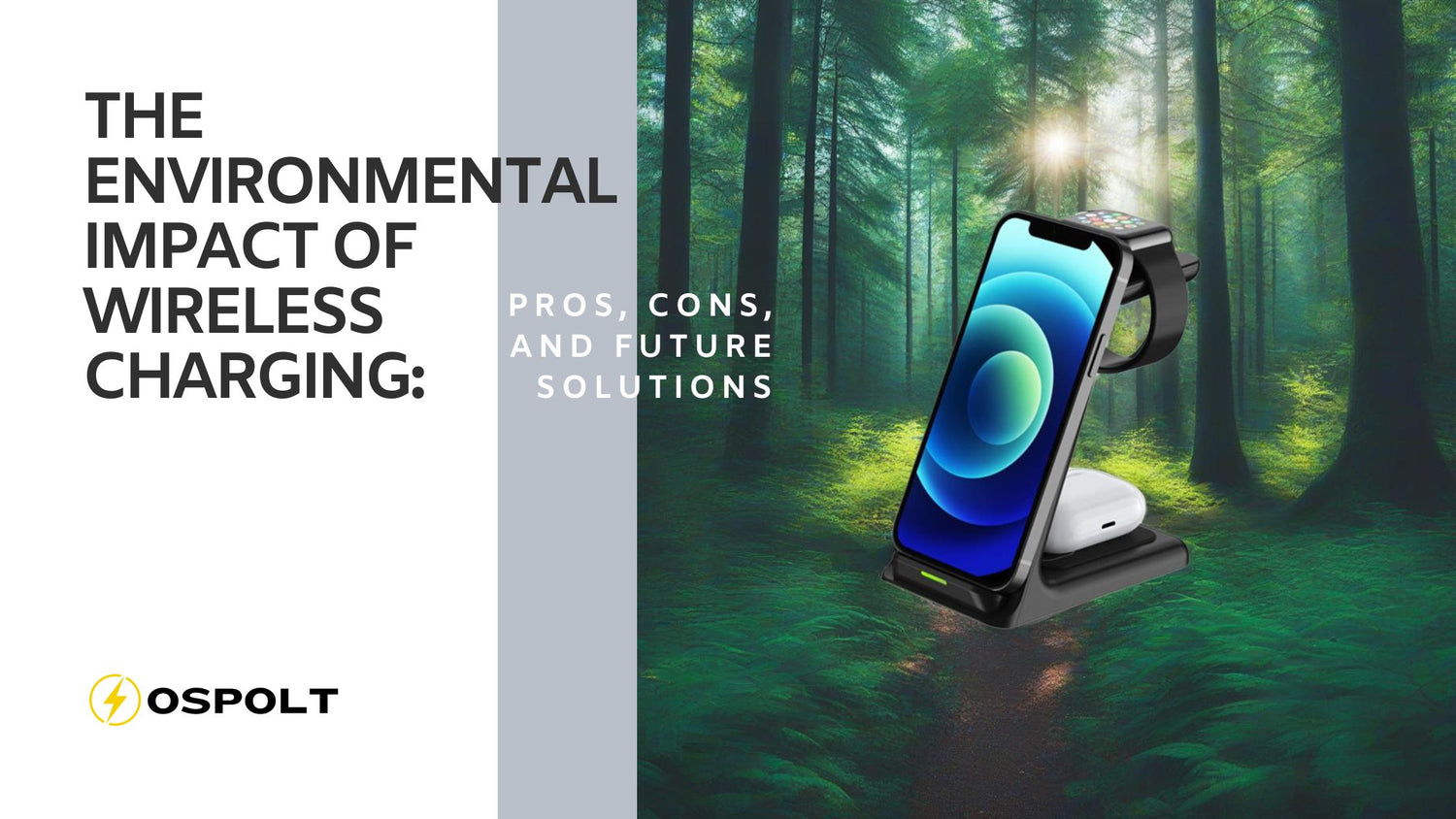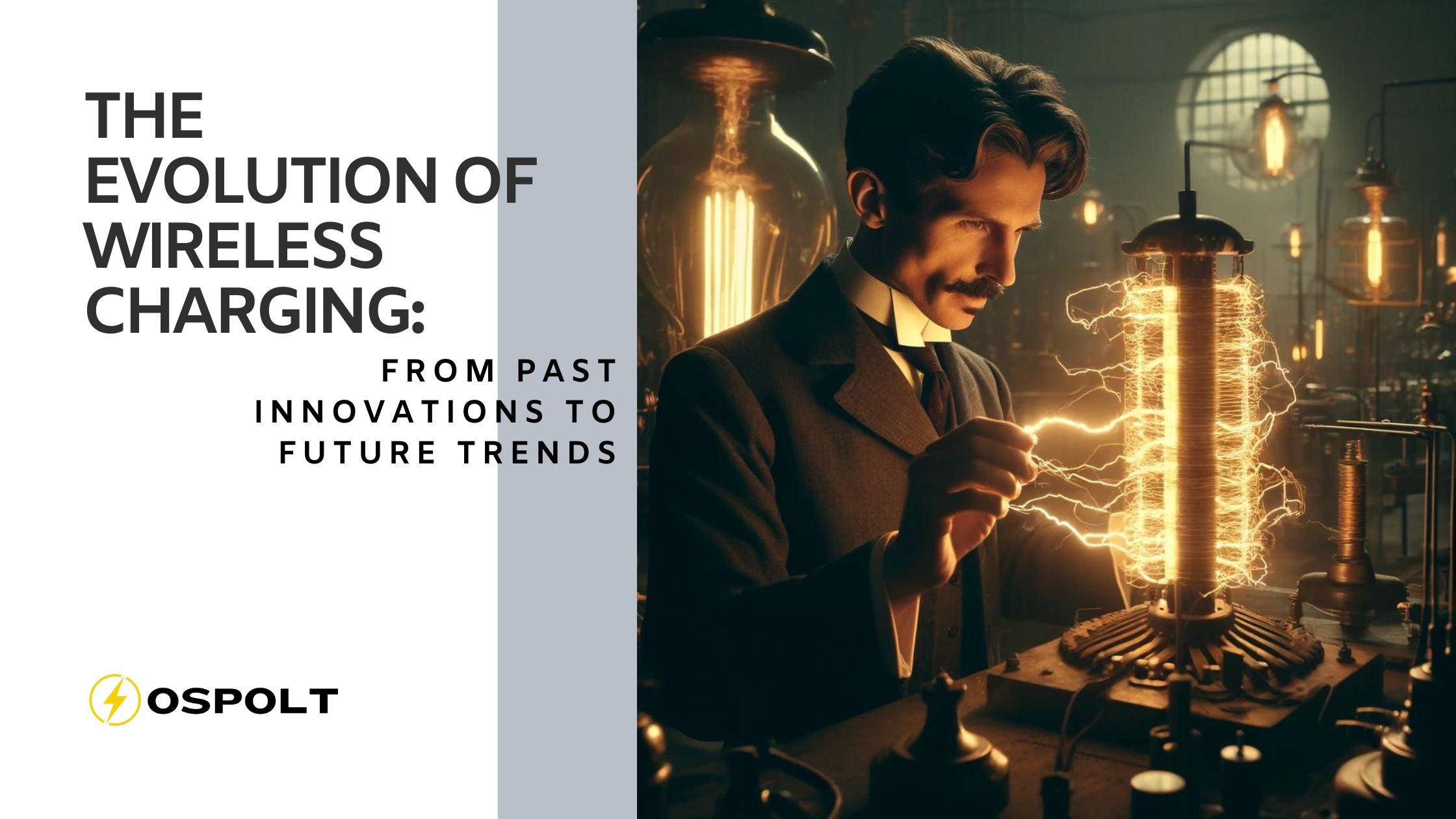Wireless charging has revolutionised the way we power up our devices, offering a convenient, cable-free solution that many of us have quickly come to rely on. Whether it's placing your phone on a charging pad or using a sleek MagSafe charger for your latest iPhone, the ease and elegance of wireless charging are undeniable. However, as with any technology, it's important to consider the broader implications, particularly the environmental impact.
In recent years, environmental sustainability has become a key concern for both consumers and manufacturers. As we become more aware of our ecological footprint, examining the environmental impact of wireless charging technologies is crucial. This blog post delves into the environmental benefits and drawbacks of wireless charging and explores what manufacturers are doing to mitigate its negative impact on the environment.
Join us as we take a closer look at the green credentials of wireless charging and discover how you can make more environmentally friendly choices in your tech usage.
The Environmental Benefits of Wireless Charging
Reduction in Electronic Waste
One of the most significant environmental benefits of wireless charging is the potential reduction in electronic waste. Traditional wired chargers often suffer from wear and tear, leading to frayed cables and broken connectors that eventually end up in landfills. In contrast, wireless chargers are typically more durable, reducing the frequency with which they need to be replaced. This longevity helps minimise the volume of electronic waste generated.
Additionally, wireless charging reduces the need for multiple cables for different devices. Many wireless chargers are designed to work with various devices, from smartphones to earbuds, which means fewer cables cluttering up your space and ultimately less waste.
Longer Lifespan of Devices
Wireless charging can also contribute to a longer lifespan for your devices. Constant plugging and unplugging can cause significant wear on charging ports, often leading to malfunction or damage over time. With wireless charging, the need to connect and disconnect cables is eliminated, preserving the integrity of your device's ports and potentially extending its usable life. This means fewer devices need to be replaced as frequently, contributing to a reduction in overall electronic waste. Read more about how wireless charging can enhance your mobile battery life here.
Energy Efficiency Improvements
Advancements in wireless charging technology have led to significant improvements in energy efficiency. Early wireless chargers were notorious for their energy loss, with much of the power being lost as heat rather than being transferred to the device. However, modern wireless chargers have become much more efficient, with many models boasting energy transfer rates that rival those of traditional wired chargers.
For example, the latest Qi-certified chargers are designed to optimise energy transfer, reducing wasted energy and ensuring that more power is directed towards charging the device. This increased efficiency not only saves energy but also reduces the carbon footprint associated with charging devices.
In summary, while wireless charging is often celebrated for its convenience, its environmental benefits are equally noteworthy. By reducing electronic waste, extending the lifespan of devices, and improving energy efficiency, wireless charging is making strides towards a more sustainable future.
The Environmental Drawbacks of Wireless Charging
Increased Energy Consumption
While wireless charging has made strides in energy efficiency, it still tends to consume more power compared to traditional wired charging. The process of inductive charging, which is the most common method used in wireless chargers, inherently involves some energy loss. This loss occurs because the energy must be transferred through an electromagnetic field, which is less efficient than a direct wired connection. As a result, wireless charging can consume more electricity to achieve the same level of battery charge, leading to a higher overall energy consumption.
Manufacturing Impact
The production of wireless chargers involves the use of various materials and energy resources, contributing to its environmental footprint. The components required for wireless charging—such as coils, circuit boards, and casing materials—necessitate the extraction and processing of raw materials. This process can be resource-intensive and can lead to environmental degradation.
Moreover, the assembly and manufacturing processes of wireless chargers can result in greenhouse gas emissions and other pollutants. As the demand for wireless charging continues to grow, the cumulative environmental impact of manufacturing these devices becomes more significant. Ensuring sustainable practices in the production phase is essential to mitigate these effects.
Disposal Issues
The disposal of wireless charging components presents another environmental challenge. Many wireless chargers contain non-recyclable materials, making them difficult to dispose of in an eco-friendly manner. Components such as plastic casings, metal coils, and electronic circuits often end up in landfills, where they can contribute to pollution and environmental harm.
Additionally, the recycling infrastructure for electronic devices is often inadequate, leading to improper disposal of e-waste. Without effective recycling programs, wireless chargers and other electronic accessories can contribute to the growing problem of electronic waste, which poses significant environmental and health risks.
Heat Generation
Wireless charging can generate more heat than wired charging, which can affect both the device and the charger itself. Excessive heat generation not only reduces energy efficiency but can also lead to faster wear and tear of the device's battery and components. Over time, this can result in the need for more frequent replacements, contributing to electronic waste.
In summary, while wireless charging offers many conveniences and some environmental benefits, it is not without its drawbacks. Increased energy consumption, the environmental impact of manufacturing, disposal challenges, and heat generation are all factors that need to be considered. Addressing these issues requires a concerted effort from manufacturers, consumers, and policymakers to develop and adopt more sustainable practices and technologies.
What Manufacturers Are Doing to Mitigate Negative Environmental Impact
Use of Sustainable Materials
Manufacturers are increasingly turning to sustainable materials in the production of wireless chargers to reduce their environmental footprint. For instance, some companies are using recycled plastics and metals, which helps to minimise the extraction of raw materials and reduces waste. Additionally, biodegradable materials are being explored for casing and packaging, which can significantly lower the environmental impact when these products reach the end of their life cycle.
Examples of brands making strides in this area include those incorporating post-consumer recycled plastics into their designs or using bamboo and other sustainable materials for the exterior casing of their chargers. These initiatives not only help the environment but also appeal to eco-conscious consumers who prioritise sustainability in their purchasing decisions.
Energy-Efficient Designs
Advancements in technology have led to the development of more energy-efficient wireless chargers. Manufacturers are focusing on minimising energy loss during the charging process, ensuring that more power is effectively transferred to the device rather than being wasted as heat. This is achieved through improved coil designs, better alignment techniques, and smarter power management systems.
For instance, some modern wireless chargers feature intelligent power control that adjusts the charging power based on the device's requirements, reducing unnecessary energy consumption. These energy-efficient designs contribute to lower overall electricity usage, making wireless charging a more environmentally friendly option.
Recycling Programs and Take-Back Initiatives
To address the issue of e-waste, several manufacturers have implemented recycling programs and take-back initiatives. These programs encourage consumers to return their old or unused wireless chargers, which are then properly recycled or repurposed. By doing so, valuable materials can be recovered, and harmful components can be disposed of safely, reducing the environmental impact.
Companies like Apple and Samsung have established robust take-back schemes where customers can drop off their old chargers and devices at designated collection points. These initiatives not only help in managing e-waste but also promote a circular economy, where products and materials are reused and recycled, reducing the need for new raw materials.
Commitment to Renewable Energy
Many manufacturers are committing to renewable energy sources to power their production facilities. By shifting to solar, wind, or hydroelectric power, companies can significantly reduce their carbon footprint. This commitment extends beyond the production process, with some companies also investing in renewable energy certificates (RECs) or carbon offset programs to further mitigate their environmental impact.
For example, tech giants like Apple have pledged to run their manufacturing operations on 100% renewable energy, which includes the production of wireless chargers. Such initiatives not only help in reducing greenhouse gas emissions but also set a positive example for the industry, encouraging other manufacturers to follow suit.
In summary, while wireless charging does have some environmental drawbacks, manufacturers are actively working to mitigate these impacts through the use of sustainable materials, energy-efficient designs, recycling programs, and commitments to renewable energy. These efforts are crucial in creating a more sustainable future for wireless charging technology and ensuring that it remains a viable option for eco-conscious consumers.
Consumer Tips for Minimising Environmental Impact
Choose Energy-Efficient Chargers
When selecting a wireless charger, look for models that are designed to be energy-efficient. These chargers are often labelled with certifications such as Energy Star or Qi certification, which indicate that they meet specific energy efficiency standards. By choosing an energy-efficient charger, you can reduce the amount of electricity consumed during the charging process, lowering your overall carbon footprint.
Proper Disposal and Recycling of Old Chargers
To minimise the environmental impact of your old chargers, ensure they are disposed of properly. Many electronic retailers and manufacturers offer recycling programs or take-back initiatives, allowing you to drop off your old chargers for proper recycling. This helps prevent e-waste from ending up in landfills and ensures that valuable materials are recovered and reused.
Additionally, check with your local recycling centres to see if they accept electronic waste. Proper disposal of old chargers not only reduces environmental harm but also supports the recycling industry, promoting a more sustainable approach to electronics disposal.
Support Brands with Sustainable Practices
As a consumer, you have the power to support brands that prioritise sustainability. When purchasing wireless chargers, research and choose companies that use eco-friendly materials, implement energy-efficient designs, and have robust recycling programs. By supporting these brands, you encourage the industry to adopt more sustainable practices and drive positive change.
Look for companies that are transparent about their environmental policies and initiatives. Brands that invest in renewable energy, use recycled materials, and offer take-back programs are typically more committed to reducing their environmental impact.
Limit the Number of Chargers
Instead of purchasing multiple chargers for different devices, opt for multi-device wireless chargers. These chargers are designed to charge several devices simultaneously, reducing the need for multiple individual chargers. This not only saves you money but also reduces the overall demand for manufacturing new chargers, which in turn lowers the environmental impact.
Opt for Durable, High-Quality Chargers
Investing in a durable, high-quality wireless charger can significantly reduce the frequency of replacements. Cheaper, low-quality chargers are more likely to break or become obsolete quickly, leading to more electronic waste. High-quality chargers, on the other hand, tend to last longer and provide better performance, reducing the need for frequent replacements and minimising waste.
Stay Informed and Educated
Stay informed about the latest advancements in wireless charging technology and environmental practices. Follow industry news, read reviews, and educate yourself on the most sustainable options available. Being informed allows you to make better purchasing decisions and adopt practices that align with your commitment to environmental sustainability.
Future Trends in Sustainable Wireless Charging
Development of More Efficient Charging Technologies
The future of wireless charging is set to see significant advancements in efficiency. Researchers and manufacturers are working on new technologies that minimise energy loss and improve power transfer rates. One promising development is resonant inductive coupling, which allows for more efficient energy transfer over greater distances compared to traditional inductive charging. This technology could lead to wireless chargers that consume less power and generate less heat, making them more environmentally friendly.
Integration with Renewable Energy Sources
As the world shifts towards renewable energy, the integration of wireless charging systems with renewable energy sources is becoming more feasible. Solar-powered wireless chargers, for instance, are gaining popularity. These chargers use solar panels to harvest energy from the sun, providing a sustainable power source for your devices. This trend not only reduces reliance on fossil fuels but also makes wireless charging more accessible in off-grid locations.
Use of Biodegradable and Recycled Materials
The use of biodegradable and recycled materials in the production of wireless chargers is expected to increase. Innovations in material science are enabling manufacturers to create components from plant-based plastics and other biodegradable substances. Additionally, there is a growing emphasis on using recycled metals and plastics, which helps reduce the demand for new raw materials and lowers the environmental impact of production.
Modular and Upgradable Designs
Future wireless chargers may feature modular and upgradable designs, allowing users to replace or upgrade specific components rather than disposing of the entire charger. This approach not only extends the lifespan of the charger but also reduces electronic waste. For example, a modular wireless charger could allow you to swap out the power module or the charging pad independently, ensuring that the device remains functional and up-to-date with the latest charging standards.
Enhanced Recycling Programs
Recycling programs for electronic devices, including wireless chargers, are expected to become more robust and widespread. Manufacturers are likely to expand their take-back initiatives and collaborate with third-party recycling firms to ensure that old chargers are processed responsibly. These enhanced recycling programs will focus on recovering valuable materials and safely disposing of hazardous components, thereby reducing the environmental impact of e-waste.
Smart Charging Systems
The future of wireless charging includes the development of smart charging systems that can optimise energy use based on the device's requirements and user habits. These systems will use artificial intelligence and machine learning to adjust charging speeds, reduce energy consumption, and even schedule charging during off-peak hours when renewable energy availability is higher. Smart charging systems can significantly enhance the efficiency and sustainability of wireless charging.
Global Standardisation and Interoperability
As wireless charging technology evolves, there is a push towards global standardisation and interoperability. Unified standards, such as the Qi standard, ensure compatibility across different devices and chargers, reducing the need for multiple chargers and cables. Standardisation also simplifies the recycling process, as components and materials can be more easily identified and processed.
Future trends in sustainable wireless charging are focused on improving efficiency, integrating renewable energy, using eco-friendly materials, and enhancing recyclability. These advancements are set to make wireless charging not only more convenient but also significantly more sustainable.
Conclusion
Wireless charging technology, while offering incredible convenience, comes with its own set of environmental challenges and benefits. By reducing electronic waste, extending device lifespans, and improving energy efficiency, wireless charging presents a positive step towards a more sustainable tech ecosystem. However, the increased energy consumption, manufacturing impact, and disposal issues cannot be overlooked.
Manufacturers are actively addressing these concerns by using sustainable materials, designing energy-efficient products, implementing recycling programs, and committing to renewable energy. As consumers, making informed choices about the chargers we use and how we dispose of them can significantly impact our environmental footprint.
The future of wireless charging is promising, with ongoing advancements aimed at making this technology even more eco-friendly. By embracing these innovations and supporting sustainable practices, we can enjoy the benefits of wireless charging while contributing to a healthier planet.





Leave a comment
All comments are moderated before being published.
This site is protected by hCaptcha and the hCaptcha Privacy Policy and Terms of Service apply.